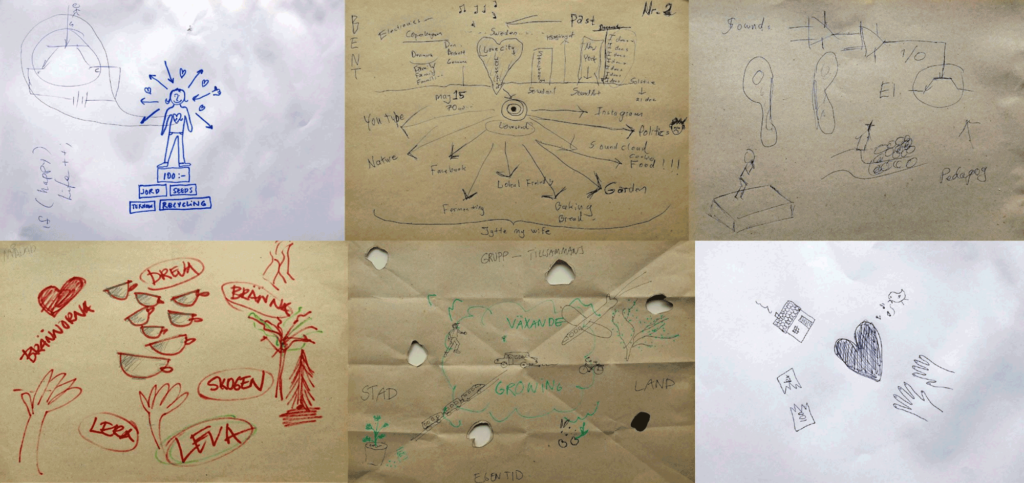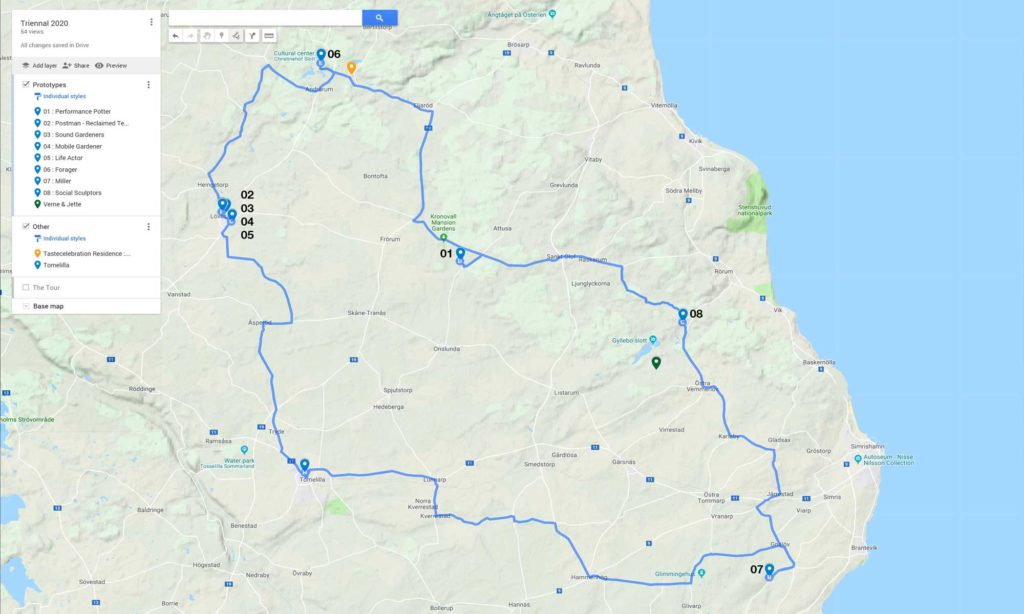Triennal 2023 will tour different forms of Creative Practice. During this pandemic, when many people are reassessing their choices, the drive to seek out different ways to work, live, and act is particularly relevant. ((The future of work is a constant subject in today’s media, whether discussing new ways to work or the future of AI. The citizen as artist, of life as creative engagement, as envisaged in New Babylon in the 60’s. A new work/life reality is drifting ever closer.))
In summer 2022 we will hold workshops with the artists.
In summer 2023 we will create tours visiting each artist group.
The Workshops are a critical first component of the exhibition. We will investigate different forms of creative practice, how the artists live now, as well as methods to encourage new forms of sustainable creative lives. The workshops will set the themes for the tours the following year.
The Tours in Skäne will be by bus, probably weekends in June/July 2023. To get a ticket for a tour, to encourage dialog, each participant fills in a form describing their imagined creative practice.
On the bus a 2 person band will play improvisation ((On the bus Robbie Lee & Hampus Ohman-Frolund and other duos will improvise, based on the tour and the themes being explored )). Each tour will have a Guide. ((The guides will be Marek Walczak / Robert Ek, and others depending on the theme of the tour))
The documentation of the workshops, tours and interviews will be the final piece of the Triennal. This will take the form of Demonstrations – modules including videos, texts and drawings creating a living website archive. The demonstrations create numerous possibilities for exhibitions and events after the tours have ended.
Marek Walczak will be the co-curator of the Triennal, in collaboration with critics/curators based in Sweden.
Participating :
Åsa Maria Bengtsson
Thore Soneson ((Åsa Maria Bengtsson and Thore Soneson will compile an essay film focusing on the workshops and artistic concepts, visualizing these experiences in different ways. This essay film will be an inspiration and a conceptual visualization of ideas and experiences that the artists bring to the bus tours.))
Gunnel Pettersson
Momiyama
Gabriella Dahlman
Jonas Larsen
Malin Lobell
Agata Bielska
Gylleboverket
Etta Safve & Jona Elfdahl
Grief & Hope
(more to come)
Examples of Creative Practice :
Gylleboverket create social sculpture in a former scrapyard. They use the impromptu spaces of the yard for installations, movies, workshops, kitchen, permaculture, performances…
Gunnel Pettersson & Momiyama have shared facilities for decades. Gunnel creates work around the ancient cultural and social cultivation of buckwheat. It could be noodle making as well as poetry or interventions. Momiyama works with worn, patched garments using the old Japanese mending technique sashiko in a contemporary way. His work tells us about time and the art of care and recycling.
Central to Malin Lobell’s poetic, conceptual and critical approach is the participatory perspective, human’s relation to nature and the importance of plants.
Another example is Jonas Larsen & Yuki Tango’s Pilglas, a collection of mouth-blown glass vessels. Glass molds are woven from locally grown willow to create unique objects with a Skånsk character. Although a serial production process, each vase is unique.

The Workshops ((This Triennal is based on example, a practical approach that looks first at contemporary art practice in the South Swedish countryside, then extends the lessons from there to include all participants. The workshops are the engine to get this done. First the artists need to visualize their own practice, then we extemporize into a set of working methods that are explored for use in the bus tours. This experimental methodology is fully documented.)) are a series of explorations :((Åsa Maria Bengtsson and Thore Soneson will compile an essay film focusing on the workshops and artistic concepts, visualizing these experiences in different ways. This essay film will be an inspiration and a conceptual visualization of ideas and experiences that the artists bring to the bus tours.))
To inspire the artists to explore and draw out their creative practices. ((The Workshops will be divided into 4 sections:
– At first each artist will draw out their own practice. This will be done through a series of visualizations.
– They then form small groups where they discover similarities and differences. These are used to create a visual compendium of art/life strategies.
– These compendiums are presented and discussed by the group, creating specific themes for the bus tours.
– Each compendium is then used in an event, open to the public, for comment and further experimentation.
The focus of the workshops then, is to use direct experience to formulate strategies to ignite and inspire the participants on the upcoming bus tours.))
To see how the artist’s experiences can be transformed into a meaningful meeting with the bus participants. ((Marek Walczak and his public art partner, Wes Heiss, create public sculpture that is intimately engaged with the community where the artwork is located. An example is Markers, a set of 5 sculptures in a new park in Denver. The Whereami component included working with school children to create signs based on their understanding of the area. In abstract, these engagements include workshops and meetings with residents, from school children to community activists to local stakeholders. We start by having them draw out their personal lives and experiences, then we break them into groups to discuss their perceptions in relationship to each other, and finally a group discussion where we try to come up with a creative consensus based upon their own discoveries. These and other participatory techniques developed by Walczak & Heiss will be used throughout this Triennal))
How to design an inventive & purposeful bus tour. ((The Agrikultura Triennal was co-curated by Marek Walczak and included some of the artists mentioned above. During this outdoor field exhibition, the audience participated in small tours, where the tour guide walked across Hillie to various artwork locations and discussed the work presented. The dialog during these tours was often spectacular, especially when someone in the audience was deeply immersed in one of the subjects, whether that was Permaculture or life on Mars. This experience provided the core of the current Triennal.))
To discover possibilities for creative practice of the tour participants. ((Essential to the Triennal is to have an audience focused on their future as a creative participant. What types of social and physical infrastructure will be valuable to them in the future? Why not use the example of the current practice of artists living in South Sweden?))

The Tours ((The tours are the heart of the Triennal. On the bus, the exhibition/experience/performance is an alternative art event. Fully documented, the performative event is inspired by the interation of the artists and the participants.))
The Form to participate on the tour will be available both online and physically at select venues in Skåne. ((The Triennal asks that each individual taking part in the event come with an aspiration. Just as children we wanted to be astronauts, princes and princesses, as we grow perhaps all of us have an aspiration, a clue to how to live, work and grow.))
In order to foster meaningful dialog each stop on the tour will be about an hour. Including travel between spots this would mean about four stops a day. Each tour will accommodate a different theme. ((Themes for the Tours:
– Nature, how to plant, grow, take care of and ameliorate the landscape.
– Society. Collaborate with a group of people, each with their own cultural inspirations.
– Food, growing, preparing, creating shared feasts.
– Healing, how to create a culture of healing.
– Individual growth. How to create a successful practice.
– How to… be a composer, a potter, a painter, a designer…))
A sample tour could combine concepts of growing, making and consuming food. Malin Lobell, Gunnel Petterson and Agata Bielska have different social and cultural takes on what we eat and where it comes from. ((The bus starts off in Tomellila. On the bus the musicians play riffs about food and feasts. The tour participants may include people who like to grow food with their children, or create stylish sustainable events with their friends, or cooks and gardeners in search of inspiration. We will visit Malin Lobell, to see the beauty of permaculture/forest gardens. Next we visit Gunnel Petterson, to learn about the ancient culture of buckwheat. Agata Bielska will lead us, foraging on a forest path. The day ends with a shared meal at Gylleboverket. Between each journey, the music is improvised, from field recordings to a joyous festive conclusion.))
The documentation, drawings, videos, music and dialogs will be gathered together into Demonstrations and become, for example, an installation at a gallery where many more people can participate, as well as an open-ended website. ((The third part of the exhibition, after the workshops and the tours, is seen as demonstrations, as a resource that grows over time. The website is an interactive database of knowledge, with links to other potential programs, some educational and some performative. Each of the Triennal’s themes will be collected into short videos, with supportive texts, that gather the ways of being, living and creating. These can be used in exhibitions, in workshops, as standalone kiosks, or presentations/demonstrations to other audiences.))

Audiences participate in the lived experiences of the artists and their communities and leave with an expanded sense of potential futures and working lives, and an understanding of new economies built on different models of love and labor.